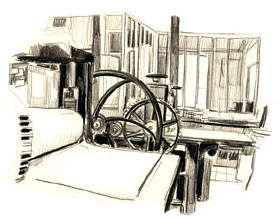From a single print to a book combining images and selected texts, the uses of the artist print are many. It is always based on careful work, returning as much as possible to traditional techniques.
1. What to print?
Printmaking combines several techniques permitting production on various media.
- Prints, works printed one by one, in limited numbers, from a drawing created on a matrix. Such is the case for lithographs, acid-etchings and other screen prints.
- High quality illustrated books, as in art books.
- Artist's books, of objects created and bound by hand, produced in very limited quantities.
Identify an original
Artists books, engravings and other modern lithographs are most often signed and certainly numbered.
- Each print carries a different number, together with a number indicating the number of prints produced: for example, 12/80.
- Some prints (a maximum of 10% of the run) are reserved for the artist: these artist's proofs are identified by Roman numerals.
2. Printing in all its forms
If the techniques have changed over time, they are still based on the same principle: print the image of a work, created on a specific matrix, on high-quality paper.
- They are printed individually, each new print requiring the re-inking of the master.
- Editions are limited, that is, a very small quantity: dry point engravings, for example, rarely exceed 20 prints, because of the fragile nature of the lines. Offset printing has made it possible for prints, especially lithographs, to become more popular, allowing reproductions in great numbers.
Three characteristics of a print
- Produced one by one, there is an original, an impression, a proof... never a reproduction. The matrix is then destroyed or rendered unusable.
- The matrix is the reverse image of the drawing, as in a mirror.
- The matrix is created by the artist or under his direction.

3. Printing techniques
In each case, the work is reproduced by ink on paper.
- The taille d'épargne (black line) method (or relief):
The work is drawn on a matrix of wood or linoleum. The engraver incises the design in the base while "saving" the line, which then appears in relief, ready to be inked and put in contact with the paper.
- Intaglio
Various methods permit engraving of the image on a plate of copper or zinc. Using a cloth, a pad or even the hand, the ink is applied in the hollows. The plate, covered with paper, is then passed between the rollers of a press. Two separate types of intaglio:
- Direct method: the carving is created using various tools (chisel method), with a fine-point stylus (dry point method) or also with a toothed metal roller (black style).
- Engraving with acid: this is the acid etching style. The plate is first protected by a varnish. The image is drawn and then engraved in the varnish, which will then be submitted to the corrosive action of an acid and cut chemically.

- Lithography (or flat-bed printing)
The artist draws on a specially treated porous stone (or on a zinc plate), using an oily medium: crayon, special ink, wax pastel... Tints, known as "ink wash," can be added. The stone is moistened, then inked with a brayer: only the oily surfaces, not affected by the water, will accept the ink. The stone is then covered by a sheet of paper and passed under a press.
- Screen printing
This method is based on the stencil concept: color is applied on the base material, through a fine fabric (nylon) with certain areas previously cut out. The result is uniform, without nuance. It is possible to apply several colors in succession. Advantages: very low cost, the rendering of colors is particularly brilliant!
- Photographic processes
Since the end of the 19th century, these processes have permitted the reproduction of images, which purists are reluctant to call a print, because the matrix is not created by the artist. The image, on transparent photographic film, is transferred to the support medium, previously covered by a photosensitive material (developing solution); the photograph is then fixed and dried. In spite of the industrial production of photographic images and then the digital revolution, some traditional techniques are still in use.
Did you know? From black... to color
Traditionally associated with black and white, the print can also, in certain conditions, be colored.
- You can color by hand, in watercolors or in gouache, even with a stencil.
- Lithographs are colored by the chromolithography process: each color is applied using a matrix (one for each color). Each imprint is successively placed on the same sheet of paper.
- Another technique, less often used: printing "à la poupée" or doll-style. This technique involves inking a single matrix selectively, juxtaposing the colors and spreading them with a finger. The print is made in a single step. The name "doll" refers to the finger of the printer... wrapped in cloth.
Recommended product:
Edition
